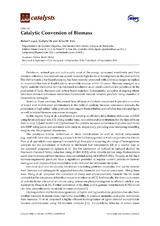Mostrar el registro sencillo del ítem
Catalytic Conversion of Biomass
| dc.contributor.author | Luque, Rafael | |
| dc.contributor.author | De, Sudipta | |
| dc.contributor.author | Balu, Alina M. | |
| dc.date.accessioned | 2017-11-09T07:57:10Z | |
| dc.date.available | 2017-11-09T07:57:10Z | |
| dc.date.issued | 2016 | |
| dc.identifier.uri | http://hdl.handle.net/10396/15375 | |
| dc.description.abstract | Petroleum, natural gas and coal supply most of the energy consumed worldwide and their massive utilization has allowed our society to reach high levels of development in the past century. The shift towards a bio-based economy has been recently promoted with ambitious targets to replace an important fraction of fossil fuels by renewable sources within 20 years. Biomass emerged as a highly suitable alternative for this bio-based revolution as an ideal substitute for petroleum in the production of fuels, chemicals and carbon-based materials. Consequently, a number of ongoing efforts have been devoted to biomass conversion/valorization towards valuable products using a number of (bio)catalytic strategies. Based on these premises, the present Special Issue of Catalysts was aimed to provide a number of broad and multifaceted contributions in the field of catalytic biomass conversion towards the production of high added value products from sugars (hemicellulose and cellulose fraction) and lignin as well as related biomass conversion strategies. In this regard, Song et al. contributed to develop an efficient dehydration of fructose to HMF using heteropolyacid salts [1]. Along similar lines, two additional contributions for the Special Issue from Li et al. [2] and Fachri et al. [3] disclosed the catalytic aqueous conversion of glucose and inulin into HMF using Lewis acid and metal salts catalysts, respectively, providing also interesting modelling insights into the proposed chemistries. The produced furanic derivatives in these contributions as well as related compounds (e.g., sorbitol) have also promising prospects to be further upgraded to fuel components for blends. Pizzi et al. provided a nice approach towards high throughput screening of a range of heterogeneous catalysts for the conversion of furfural to bio-based fuel components [4] in a similar way to the approach proposed by Iglesias et al. for the conversion of furfural to furfuryl alcohol via Meerwein-Ponndorf-Verley reduction using Zr-SBA-15 [5], while valuable jet-fuel range hydrocarbons could also be produced from biomass-derived sorbitol using Ni-HZSM-5/SBA-15 catalysts [6]. Such biomass-engineered products have a significant potential to replace current petroleum-derived analogues with improved biocompatibility and a reduced environmental footprint. Levulinic acid and levulinates are related interesting platform molecules that can be derived from biomass and subsequently upgraded towards chemicals and biofuel precursors. Along these lines, Wang et al. proposed the utilization of cheap and environmentally friendly Nb/Al oxide catalysts for the conversion of kiwifruit waste to levulinic acid [7]. Additionally, the direct conversion of carbohydrates into ethyl levulinate using potassium phosphotungstate as efficient catalyst was reported by Zhao et al. [8]. Further conversion of levulinic acid to gamma-valerolactone (GVL) could also take place efficiently on nickel/alumina catalysts [9]. Hydrogenation and hydrodeoxygenation of lignin and lignocellulosic pyrolysis has also been another hot topic in recent times due to the possibility to produce aromatics and cyclic derivatives from biomass. Yi et al. proposed a highly efficient hydrogenation of lignin derived monophenols towards cyclohexanols using Pd/alumina catalysts [10]. Co-pyrolysis behavior of cotton straw mixtures and their catalytic hydrodeoxygenation were also investigated by Hua et al. [11] using Ni-Mo/alumina catalysts. Additional contributions to the Special Issue included the selective production of aromatics from 2-octanol on Zn-exchanged MFI zeolites [12], the electrocatalytic oxidation of cellulose to gluconate on carbon aerogel supported gold nanoparticles anodes [13] and the steam reforming of bioethanol to hydrogen catalyzed by Co/ceria catalysts [14]. The Guest Editors sincerely hope that the results presented as part of this Special Issue of most varied topics can serve as a starting point for further innovations in the catalytic conversion of biomass and look forward to enjoying further improvements in the aforementioned topics and fields in the future. | es_ES |
| dc.format.mimetype | application/pdf | es_ES |
| dc.language.iso | eng | es_ES |
| dc.publisher | MDPI | es_ES |
| dc.rights | https://creativecommons.org/licenses/by/4.0/ | es_ES |
| dc.source | Catalysts 6(10), 148 (2016) | es_ES |
| dc.subject | Catalysis | es_ES |
| dc.subject | Biomass | es_ES |
| dc.title | Catalytic Conversion of Biomass | es_ES |
| dc.type | info:eu-repo/semantics/article | es_ES |
| dc.relation.publisherversion | http://dx.doi.org/10.3390/catal6100148 | es_ES |
| dc.rights.accessRights | info:eu-repo/semantics/openAccess | es_ES |

